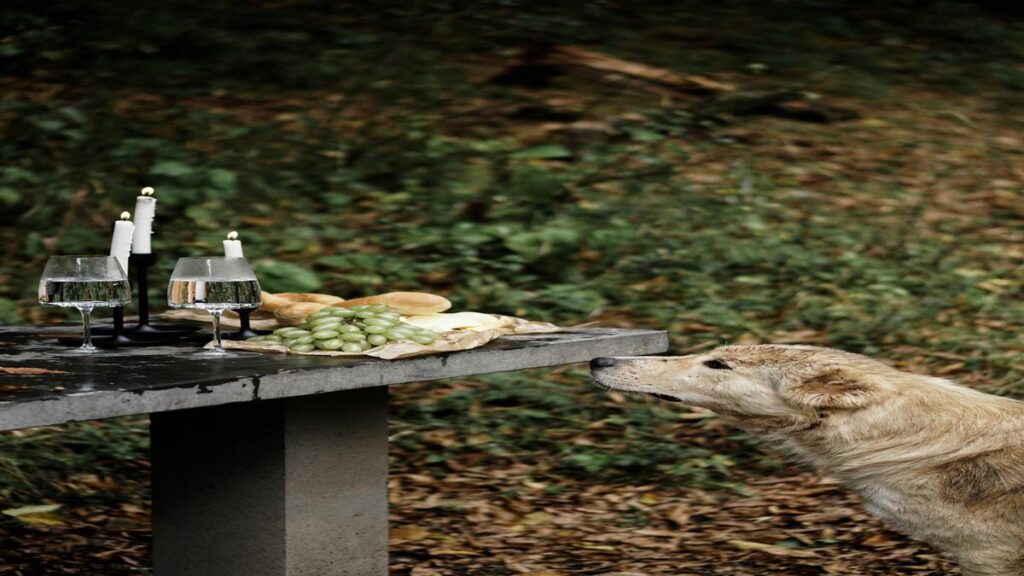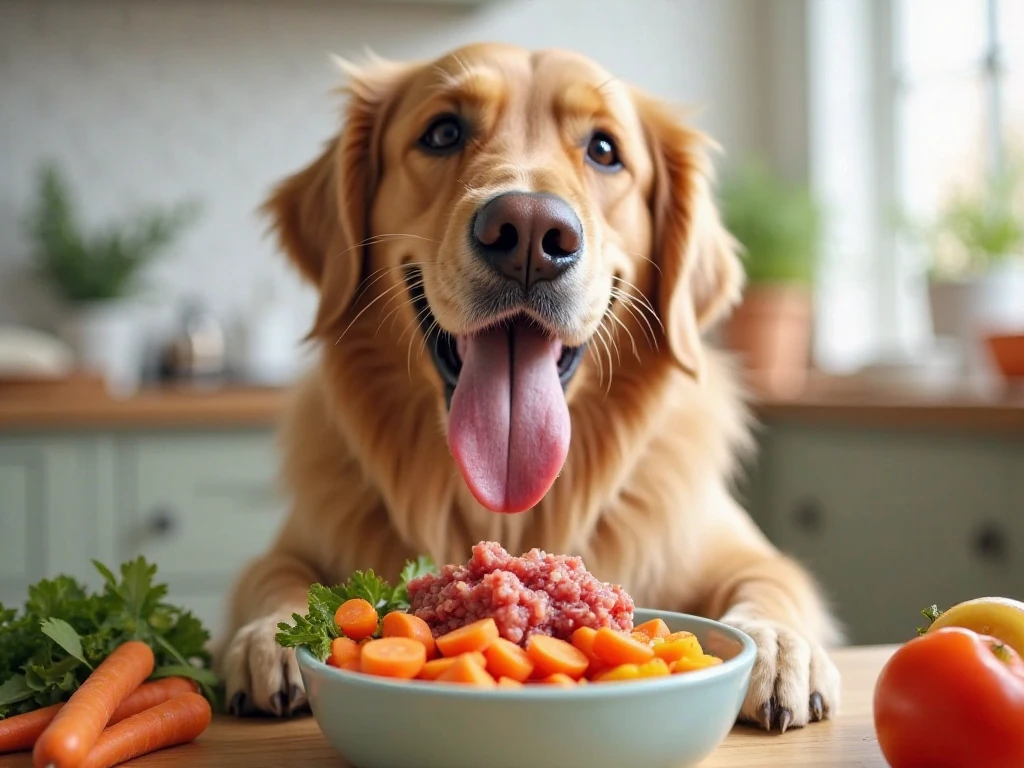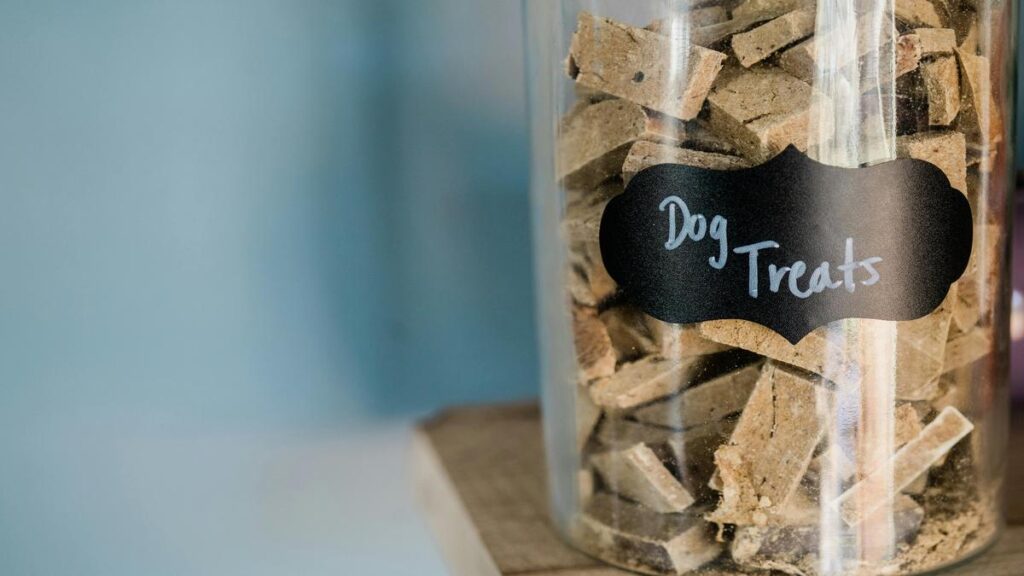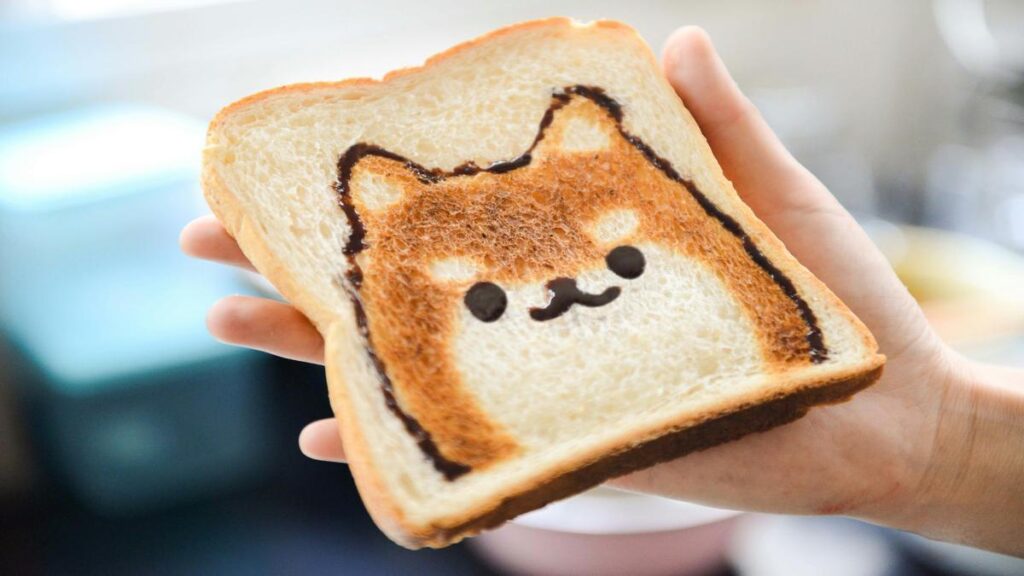The Essential Guide to Natural Dog Diets is here to help you make the best choices for your furry friend.
You’ll discover what a natural diet really means and why it matters.
From raw food options to homemade meals, we’ll cover everything you need. Get ready to learn about healthy snacks, nutritional basics, and how to switch your pup to a better diet. Your dog will thank you!
Key Takeaways
- Your dog benefits from whole foods.
- Meat, veggies, and grains are key.
- Avoid processed foods and additives.
- Always consult your vet before changing diets.
- Fresh water is a must every day.

Summary
What Are Natural Dog Diets?
Alright, let’s dive right in. When we talk about natural dog diets, we’re referring to feeding your furry friend a diet that’s as close to what they’d eat in the wild. Think fresh, whole foods that are minimally processed. This could be raw meat, vegetables, and grains—basically, anything that resembles the diet of a wild canine. The idea is to avoid artificial additives, fillers, and overly processed ingredients that you often find in commercial dog foods. For more insights on this, check out what you need to know about natural diets for dogs.
You might wonder, Isn’t all dog food made for dogs? Well, yes, but not all of it is made equally. Some commercial brands load up on stuff that’s not great for our pets. Natural dog diets aim to provide wholesome nutrition, just like Mother Nature intended.
Why Choose a Natural Diet for Your Dog?
Choosing a natural diet for your dog can be a game changer. First off, many pet owners notice a significant boost in their dog’s energy levels. Ever seen a pup bounce around like a kid in a candy store? That’s the kind of energy you might see when you switch to a natural diet. To learn more about boosting your dog’s vitality, check out this resource.
But it’s not just about energy. Dogs on natural diets often have shinier coats, healthier skin, and better digestion. Plus, fewer allergies and sensitivities are reported. It’s like giving your dog a little health upgrade. And who doesn’t want that for their best buddy?
Also, let’s be real: feeding your dog natural foods can be a bonding experience. Cooking for them or preparing their meals can be a fun way to show you care. It’s like you’re in this together, and that’s pretty special.
The Benefits of a Balanced Dog Diet
Now, what exactly does a balanced dog diet entail? It’s all about giving your dog the right mix of proteins, fats, carbohydrates, vitamins, and minerals. Just like us, dogs need a variety of nutrients to thrive. A balanced diet helps maintain their overall health and prevents a slew of potential issues down the line. For tips on achieving this balance, consult this guide.
Here are some benefits of a balanced diet for dogs:
- Improved Digestion: A diet rich in fiber can help keep things moving smoothly in your dog’s tummy.
- Healthy Weight: Feeding them the right portions of the right foods can help prevent obesity.
- Stronger Immune System: Nutrient-dense foods can boost their immune system, making them less prone to illnesses.
- Better Mood: Believe it or not, a proper diet can influence your dog’s mood. A happy dog is a well-fed dog!
So, if you want your dog to feel their best, focusing on a balanced diet is key.
Understanding Canine Nutrition Basics
When it comes to canine nutrition, there are a few basics to keep in mind. Dogs are omnivores, which means they can eat a mix of animal and plant-based foods. But not all foods are equal. Here’s a quick rundown of what you should include in their diet:
- Proteins: This is the building block of your dog’s diet. Look for high-quality sources like chicken, beef, fish, and eggs. Proteins help with muscle development and overall growth.
- Fats: Healthy fats are essential for energy and a shiny coat. Think fish oil or flaxseed oil. Just like us, dogs need a bit of fat in their diet.
- Carbohydrates: While dogs don’t need carbs as much as we do, they can benefit from sources like sweet potatoes, brown rice, and oats. These provide energy and fiber.
- Vitamins and Minerals: These are crucial for various bodily functions. Fresh fruits and veggies can provide these nutrients. Carrots, blueberries, and spinach are all great options.
- Water: Don’t forget about hydration! Always ensure your pup has access to fresh water.
Understanding these basics can help you make informed choices about what to feed your dog. For a deeper dive, visit this comprehensive guide.
Exploring Raw Dog Food Options
Now, let’s talk about raw dog food. This trend has been gaining popularity, and for good reason. The idea behind raw feeding is to provide your dog with a diet that mimics what they would eat in the wild. This often includes raw meat, bones, fruits, and veggies.
But before you jump in, it’s crucial to do your homework. Not all raw diets are created equal. Here are some things to consider:
- Variety is Key: A balanced raw diet should include different types of meat and organs. Think chicken, beef, and even fish. This variety ensures your dog gets a range of nutrients.
- Bones: Raw bones can be great for dental health, but avoid cooked bones as they can splinter.
- Consult Your Vet: Before making any drastic changes, it’s always smart to chat with your vet. They can help you create a plan that’s right for your dog.
Raw feeding can be a bit of a commitment, but many dog owners swear by its benefits. Just make sure you’re informed and prepared. For more on this topic, refer to these natural diet hacks.
If you are someone who does not have time to prepare food for your pet, consult a veterinarian about this kibble Dr. Harvey’s Canine Health Miracle Dog Food. and to read about this Reviews
Easy Homemade Dog Meals You Can Try
If you’re feeling adventurous, why not whip up some homemade dog meals? It’s easier than you think, and your pup will love you for it! Here are a couple of simple recipes to get you started:
Chicken and Rice
- Cook 1 cup of brown rice.
- In a separate pot, boil 1 chicken breast until fully cooked. Shred it into small pieces.
- Mix the chicken with the rice and add a bit of steamed broccoli or carrots.
Beef Stew
- Brown 1 pound of ground beef in a pan.
- Add 1 cup of chopped carrots and 1 cup of peas. Cook until veggies are tender.
- Mix in 2 cups of water and let it simmer for about 20 minutes. Cool before serving.
These meals are simple, nutritious, and your dog will gobble them up. Plus, you can adjust the ingredients based on your dog’s preferences. For more recipes, check out this list of healthy and delicious recipes.
Nutrient-Rich Dog Food: What to Include
When you’re shopping for nutrient-rich dog food, keep an eye out for a few key ingredients. Here’s what you want to see on the label:
- Whole Proteins: Look for meat as the first ingredient. This means your dog is getting quality protein right off the bat.
- Healthy Fats: Ingredients like chicken fat or fish oil are great for your dog’s coat and energy.
- Whole Grains: If your dog can handle grains, opt for whole grains like brown rice or oats instead of fillers like corn or soy.
- Fruits and Vegetables: Ingredients like blueberries, carrots, and spinach can provide essential vitamins and minerals.
Avoid foods that list vague terms like meat by-products or have a long list of chemical additives. If you can’t pronounce it, chances are your dog shouldn’t eat it either. For further guidance, see this ultimate guide on dog food labels.
Delicious Dog Food Recipes for Every Picky Eater
Got a picky eater on your hands? No worries! Here are a few delicious dog food recipes that are sure to please even the fussiest of pups:
Sweet Potato and Turkey
- Boil 1 sweet potato until soft, then mash it.
- Cook 1 pound of ground turkey in a pan.
- Mix the turkey with the sweet potato and add some green beans for extra crunch.
Fish and Veggie Delight
- Bake 1 fillet of salmon until cooked through.
- Steam some carrots and peas.
- Mix everything together, and your dog will have a nutritious meal that’s packed with omega-3s.
These recipes are not only tasty but also easy to make. Plus, you can switch up the ingredients based on what your dog loves. For more creative ideas, check out this guide on preparing natural meals.
Natural Dog Treats: Healthy Snacks for Your Pup
Let’s not forget about natural dog treats! Just like us, dogs enjoy a little snack now and then. Instead of reaching for those store-bought treats loaded with preservatives, why not make your own? Here are a couple of easy ideas:
Peanut Butter Biscuits
- Mix 1 cup of whole wheat flour, 1/2 cup of peanut butter, and 1/4 cup of water.
- Roll out the dough and cut it into shapes.
- Bake at 350°F for about 20 minutes.
Banana Chews
- Slice a banana and place the slices on a baking sheet.
- Bake at 250°F for about 2 hours until they’re dried out.
These treats are healthy, simple, and your dog will love them. Plus, you can feel good knowing exactly what’s in them! For more snack ideas, see this list of healthy foods.
Holistic Pet Nutrition: A Well-Rounded Approach
When we talk about holistic pet nutrition, we’re looking at the whole picture. It’s not just about what your dog eats; it’s also about their overall well-being. This means considering factors like mental stimulation, exercise, and regular vet check-ups.
A holistic approach encourages you to think about your dog’s lifestyle. Are they getting enough playtime? Are they stressed? All these factors can impact their health. So, while food is crucial, don’t forget about the other aspects of their life. For tips on transitioning to a natural diet, refer to this proven method.
Tips for Transitioning to a Natural Diet
Thinking about making the switch to a natural diet? Here are some tips to help your dog adjust smoothly:
- Take it Slow: Gradually introduce new foods over a week or two. Start by mixing a small amount of the new food with their regular food.
- Watch for Reactions: Keep an eye on your dog’s behavior and health. If they seem to have an upset stomach, you might need to slow down the transition.
- Stay Consistent: Once you find a routine that works, stick with it. Dogs thrive on consistency, and it helps them feel secure.
- Get Creative: If your dog is hesitant, try adding some tasty toppings, like a bit of broth or a sprinkle of cheese.
Transitioning to a natural diet can be a wonderful journey for you and your dog. Just be patient and attentive to their needs.
Common Myths About Natural Dog Diets
There are quite a few myths floating around about natural dog diets. Let’s bust some of these misconceptions:
- Myth 1: Natural diets are too expensive. While some natural foods can be pricier, making your own meals can actually save you money in the long run. Explore these hacks for budget-friendly options.
- Myth 2: Dogs can’t digest raw food. Many dogs thrive on raw diets, but it’s essential to do it right. Consult with your vet to ensure you’re meeting their nutritional needs.
- Myth 3: All dog food is the same. Nope! There’s a big difference between high-quality natural foods and processed kibble. Always read labels and do your research. For more information on choosing the right kibble, see this guide.
By understanding the truth behind these myths, you can make better choices for your dog’s health.
The Essential Guide to Natural Dog Diets: Final Thoughts
So, there you have it! A comprehensive look at natural dog diets. It’s all about providing your pup with wholesome, nutritious food that supports their health and happiness. Whether you’re cooking at home, exploring raw options, or simply reading labels more carefully, every little effort counts.
Remember, every dog is unique, and what works for one might not work for another. Always listen to your pup’s needs and consult with your vet whenever you’re unsure.
If you’re ready to take the plunge into the world of natural dog diets, start small and enjoy the journey with your furry friend. They’ll thank you with wagging tails and happy barks!

Conclusion
In wrapping things up, you now have the know-how to embark on this exciting journey into the world of natural dog diets. Remember, it’s all about nourishing your furry friend with wholesome, nutrient-rich foods that can truly make a difference in their health and happiness.
Whether you choose to whip up homemade meals, explore raw options, or simply be more mindful of what’s in their food, every little change counts. So, take it one paw at a time, listen to your dog’s needs, and don’t forget to consult your vet along the way.
Your dog is more than just a pet; they’re family. And with a little effort, you can ensure they live their best life. If you’re hungry for more tips, tricks, and tasty recipes, be sure to check out more articles at Tech Havela. Happy feeding!
Frequently Asked Questions
What is a natural dog diet?
A natural dog diet is made from whole foods. It includes meat, veggies, and grains. No artificial additives or processed ingredients.
Why should I feed my dog a natural diet?
A natural diet can boost your dog’s health. It helps with digestion, energy, and coat shine. Plus, it can reduce allergies!
What are some recommended foods for a natural dog diet?
You can give your dog chicken, beef, fish, sweet potatoes, and carrots. Remember to include some rice or oats too!
Are there any foods I should avoid?
Yes! Avoid chocolate, grapes, onions, and garlic. These can be toxic for dogs.
How can I balance my dog’s natural diet?
Aim for a mix of proteins, carbs, and fats. You can follow guides from The Essential Guide to Natural Dog Diets for tips.
Can I switch my dog to a natural diet suddenly?
It’s best to transition slowly. Gradually mix in natural foods over a week to avoid stomach upset.
Where can I find recipes for natural dog diets?
You can look online or check out The Essential Guide to Natural Dog Diets. Many great recipes are available there!
**Sidnir Vieira**
Founder of TechHavela
A passionate pet and tech content creator, helping dog owners across the U.S. make smarter decisions for their furry friends.



